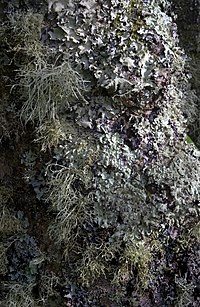
Photo from wikipedia
PREMISE OF THE STUDY The Hymenochaetales are dominated by lignicolous saprotrophic fungi involved in wood decay. However, the group also includes bryophilous and terricolous taxa, but their modes of nutrition… Click to show full abstract
PREMISE OF THE STUDY The Hymenochaetales are dominated by lignicolous saprotrophic fungi involved in wood decay. However, the group also includes bryophilous and terricolous taxa, but their modes of nutrition are not clear. Here, we investigate patterns of carbon and nitrogen utilization in numerous non-lignicolous Hymenochaetales and provide a phylogenetic context in which these non-canonical ecological guilds arose. METHODS We combined stable isotope analyses of δ13 C and δ15 N and phylogenetic analyses to explore assignment and evolution of nutritional modes. Clustering procedures and statistical tests were performed to assign trophic modes to Hymenochaetales and test for differences between varying ecologies. Genomes of Hymenochaetales were mined for presence of enzymes involved in plant cell wall and lignin degradation and sucrolytic activity. KEY RESULTS Three different trophic clusters were detected - biotrophic, saprotrophic, and a second biotrophic cluster including many bryophilous Hymenochaetales and mosses. Non-lignicolous Hymenochaetales are generally biotrophic. All lignicolous Hymenochaetales clustered as saprotrophic and most terricolous Hymenochaetales clustered as ectomycorrhizal. Overall, at least 15 species of Hymenochaetales are inferred as biotrophic. Bryophilous species of Rickenella can degrade plant cell walls and lignin, and cleave sucrose to glucose consistent with a parasitic or endophytic life style. CONCLUSIONS Most non-lignicolous Hymenochaetales are biotrophic. Stable isotope values of many bryophilous Hymenochaetales cluster as ectomycorrhizal or in a biotrophic cluster indicative of parasitism or an endophytic life style. Overall, trophic mode diversity in the Hymenochaetales is greater than anticipated, and non-lignicolous ecological traits and biotrophic modes of nutrition are evolutionarily derived features.
Journal Title: American journal of botany
Year Published: 2018
Link to full text (if available)
Share on Social Media: Sign Up to like & get
recommendations!